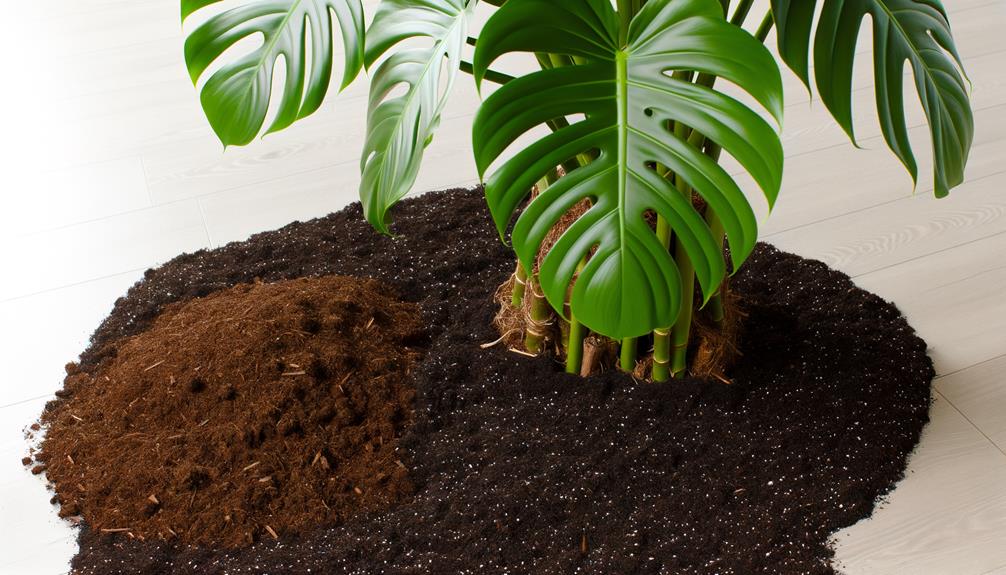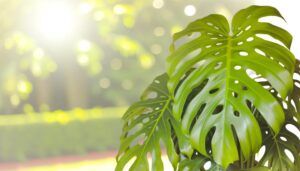Monstera Acacoyaguensis Soil Type
For growing Monstera Acacoyaguensis, use a well-draining soil mix with a 60% organic and 40% inorganic composition. Integrate peat moss or coco coir for moisture retention, and add perlite or pumice to enhance soil aeration.
Mix in orchid bark to improve soil structure and create air pockets. Maintain the soil pH between 5.5 and 7.0 for best nutrient uptake.
Incorporate balanced macronutrients like nitrogen, phosphorus, and potassium, and use a water-soluble fertilizer with a 20-20-20 N-P-K ratio. Proper drainage is essential to prevent root rot and support vigorous growth.
Discover more about perfecting your Monstera's soil needs.

Key Takeaways
- Use well-draining soil to prevent root rot.
- Incorporate peat moss or coco coir for moisture retention.
- Add perlite or pumice to increase soil aeration and drainage.
- Maintain a soil pH between 5.5 and 7.0 for optimal nutrient absorption.
- Mix in orchid bark to improve soil structure and provide air pockets.
Ideal Soil Composition
For best growth, Monstera Acacoyaguensis requires a well-draining soil mixture that balances aeration and moisture retention. You should use a blend of organic and inorganic materials. Incorporate peat moss or coco coir to retain moisture while providing essential nutrients. Add perlite or pumice to enhance aeration and prevent compaction.
A ratio of 60% organic to 40% inorganic components works well. Mixing in orchid bark increases soil structure and mimics the plant's natural epiphytic environment, promoting root health. Avoid overly dense materials like clay, which hinder root oxygenation.
Importance of Drainage
Maintaining proper drainage is essential to prevent root rot and ensure the Monstera Acacoyaguensis thrives in its well-balanced soil mixture.
You need a substrate with high porosity to facilitate efficient water flow. Incorporate materials like perlite, pumice, or coarse sand to enhance aeration and avoid water stagnation. These components create air pockets, allowing oxygen to reach the roots, which is crucial for cellular respiration and nutrient uptake.
Without adequate drainage, excess water can accumulate, leading to hypoxic conditions that foster pathogenic fungi. Make sure your pot has drainage holes and use a well-draining soil mix. Regularly check the substrate's moisture level; it should be moist but not waterlogged.
Proper drainage is essential for maintaining a healthy root environment.
Nutrient Requirements
Monstera Acacoyaguensis requires a balanced nutrient profile, including macronutrients like nitrogen, phosphorus, and potassium, to support robust growth and vibrant foliage. You'll need to make sure the plant receives sufficient nitrogen for leaf development, phosphorus to enhance root growth and flower production, and potassium for overall plant health and disease resistance.
Micronutrients such as magnesium, iron, and calcium are also crucial for chlorophyll production and cellular function. Regularly apply a well-balanced, water-soluble fertilizer with an N-P-K ratio like 20-20-20 to maintain ideal nutrient levels.
Additionally, incorporating organic matter such as compost or worm castings into the soil can improve nutrient availability and soil structure, providing a favorable environment for healthy root systems.
Ph Levels
Maintaining that the soil pH falls within the ideal range of 5.5 to 7.0 is essential for Monstera Acacoyaguensis to effectively absorb the necessary nutrients for its growth and health. When the pH level deviates from this range, nutrient uptake is compromised, leading to deficiencies or toxicities.
You should regularly test the soil pH using a reliable pH meter or test kit. If the pH is too low (acidic), consider adding lime to raise it. Conversely, if the pH is too high (alkaline), sulfur or peat moss can help lower it.
Consistent monitoring and adjustments ensure that the soil environment remains optimal for the Monstera Acacoyaguensis, promoting vigorous growth and vibrant foliage.
Organic Matter
Incorporating natural matter into the soil greatly enhances its structure, nutrient content, and moisture retention, essential for the robust growth of Monstera Acacoyaguensis.
Natural matter, such as compost, aged manure, and leaf mold, provides a slow-release source of nutrients like nitrogen, phosphorus, and potassium. It also promotes beneficial microbial and fungal activity, vital for nutrient cycling and soil health.
Decomposed natural material improves soil aggregation, which enhances root penetration and water infiltration.
Additionally, natural matter increases the soil's cation exchange capacity (CEC), allowing it to retain and supply essential minerals to the plant.
Aeration
When considering aeration for Monstera Acacoyaguensis, you'll find it's important for root respiration and overall plant health.
Incorporating perlite or orchid bark can greatly improve soil structure, enhancing oxygen flow to the roots.
However, be cautious of over-compaction, as it limits aeration and can result in root rot.
Importance of Aeration
Proper aeration is crucial for Monstera acacoyaguensis, as it facilitates root respiration and prevents waterlogging, thereby promoting healthier plant growth. You'll need to make sure the soil is porous to allow oxygen to penetrate the root zone. Compacted soil restricts air flow, leading to anaerobic conditions which can cause root rot.
Utilize substrates like perlite, pumice, or orchid bark to enhance soil structure. These materials create air pockets, improving gas exchange. Additionally, well-aerated soil ensures efficient nutrient uptake, as oxygen is essential for root metabolic processes.
Regularly check the soil's texture and moisture level to maintain ideal aeration. By prioritizing proper aeration, you'll foster robust root systems and overall plant strength.
Soil Amendments Needed
To improve aeration in the soil for Monstera acacoyaguensis, incorporate amendments such as perlite, pumice, and orchid bark to create a porous, oxygen-rich environment. Perlite's lightweight, volcanic origin guarantees ideal drainage and air pockets. Pumice, a naturally occurring volcanic glass, offers similar advantages with added durability. Orchid bark, obtained from fir trees, provides organic material that decomposes slowly, maintaining structure.
| Amendment | Composition | Advantages |
|---|---|---|
| Perlite | Expanded volcanic glass | Excellent drainage, air pockets |
| Pumice | Natural volcanic glass | Sturdy, enhances aeration |
| Orchid Bark | Fir tree bark | Organic, preserves structure |
Incorporating these amendments into your potting mix ensures that the Monstera acacoyaguensis roots receive the necessary oxygen, promoting vigorous growth and preventing root rot.
Common Aeration Mistakes
A common mistake in aeration is compacting the soil too tightly, which severely restricts oxygen flow to the Monstera acacoyaguensis roots. This can result in root rot, stunted growth, and nutrient deficiencies.
To ensure ideal soil aeration, follow these guidelines:
- Avoid Overwatering: Excess water leads to soil compaction and reduced air spaces.
- Use Perlite or Pumice: These amendments increase soil porosity, promoting better airflow.
- Regularly Loosen Soil: Gently till the top layer to maintain aeration without damaging roots.
- Repot Periodically: Revitalizing soil every 1-2 years prevents it from becoming too compacted.
Soil Moisture
Maintaining ideal soil moisture is critical for the health of Monstera Acacoyaguensis, as inconsistent watering can lead to root rot or dehydration. You should aim for consistently moist, but not waterlogged, soil. Utilize a well-draining mix that retains some moisture, like one comprising peat moss, perlite, and orchid bark.
Check the soil's moisture level by inserting your finger about an inch deep; it should feel damp, not soggy. Avoid letting the soil dry out completely between waterings, as this can stress the plant. Use a moisture meter for accuracy, ensuring the reading stays within the moderate range.
Proper humidity levels, around 60%, also aid in maintaining soil moisture balance and promoting best growth.
Conclusion
So, you thought growing Monstera acacoyaguensis would be easy with just any soil? Think again. You need well-draining soil, precise pH levels between 5.5 and 7, and a balanced mix of organic matter and nutrients.
Aeration is essential, so don't forget those perlite or bark chunks. Keep the soil moist but not waterlogged. Ironically, this intricate care mimics its natural habitat perfectly—guess Mother Nature really knows best, huh?
Happy planting!






